A Closer Look at Frederic Remington's Old Dragoons of 1850
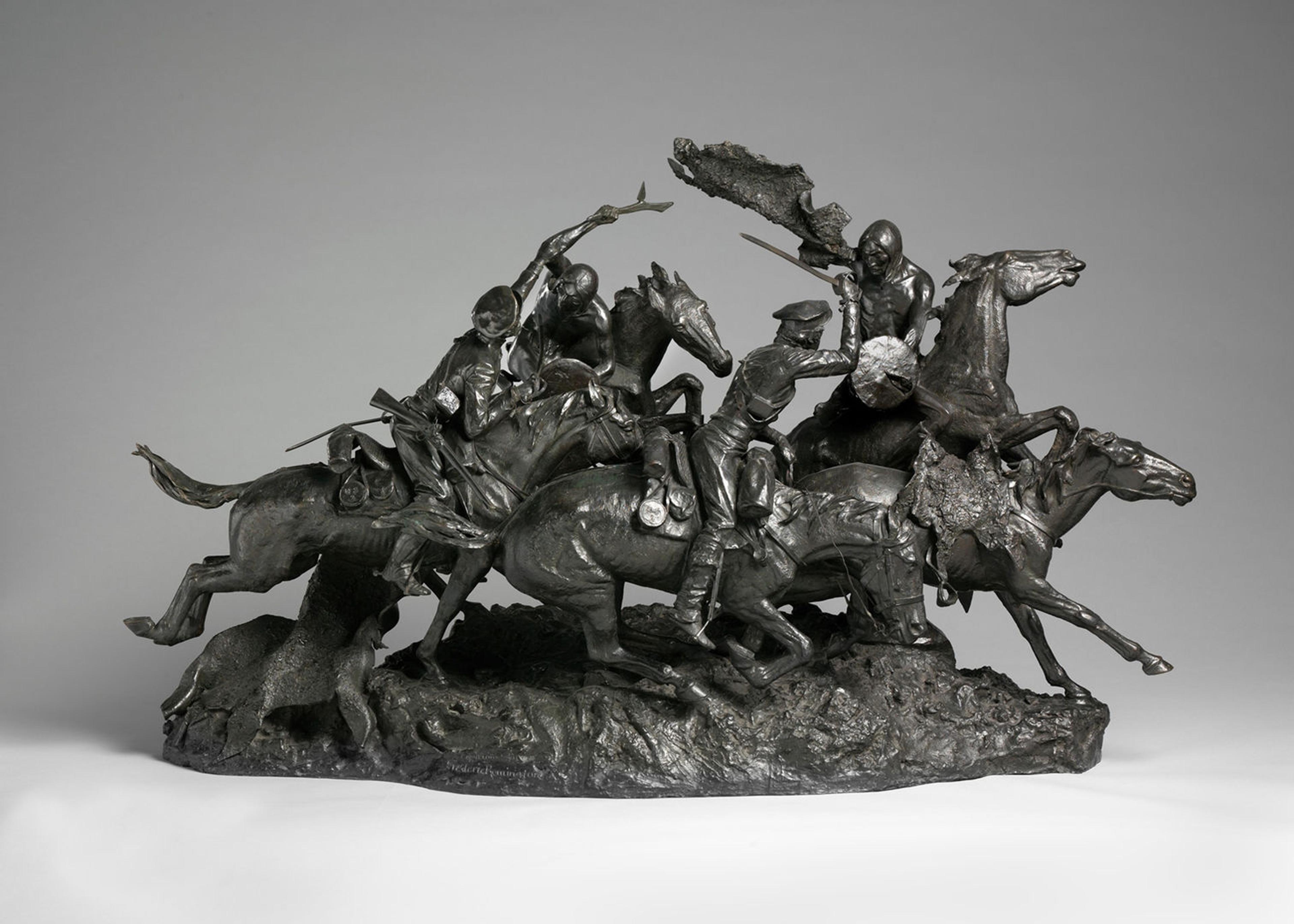
Frederic Remington (American, 1861–1909). The Old Dragoons of 1850, 1905, cast 1907. Bronze, 26 7/8 x 47 x 17 in. (68.3 x 119.4 x 43.2 cm). The Metropolitan Museum of Art, New York, Purchase, Rogers Fund, 1907 (07.77)
Oftentimes, questions and observations we receive about works of art included in Met exhibitions spawn further research and yield fresh discoveries. Such was the case when a writer for the Wall Street Journalreviewing Frederic Remington at The Met posed the question of how many pieces were used in casting the sculptor's tour-de-force The Old Dragoons of 1850. Since the 1980s, many Remington bronzes have undergone extensive technical analysis, but we were unable to resolve his question about this particularly intricate cast based on existing documentation. After the exhibition closed on January 2, 2018, we satisfied the writer's curiosity—and our own—and undertook a detailed study of this sculpture.
Modeled in 1905, Old Dragoons is by far Remington's most complex statuette. It depicts a dynamic stop-action group featuring four riders and five horses at full gallop. Two mounted soldiers of the US Regiment of Dragoons—cavalry that patrolled the Western territories during the mid-nineteenth century—are interlocked in hand-to-hand combat with two Native Americans. The lead horse is riderless, yet is equipped with a saddle of Plains Indian origin, adding ambiguity to the narrative.
In spite of Remington's prowess as a storyteller and his keen attention to visual detail, his interest here was not in establishing a clear outcome to the dramatic skirmish—he left that for viewers to imagine for themselves. Rather, he emphasized the daring, virtuoso casting of this complex multi-figure composition in which just seven of the horses' twenty hooves are connected with the base. These few points of contact support the weight of the elevated group of horses and riders careening across the rocky terrain at high speed.
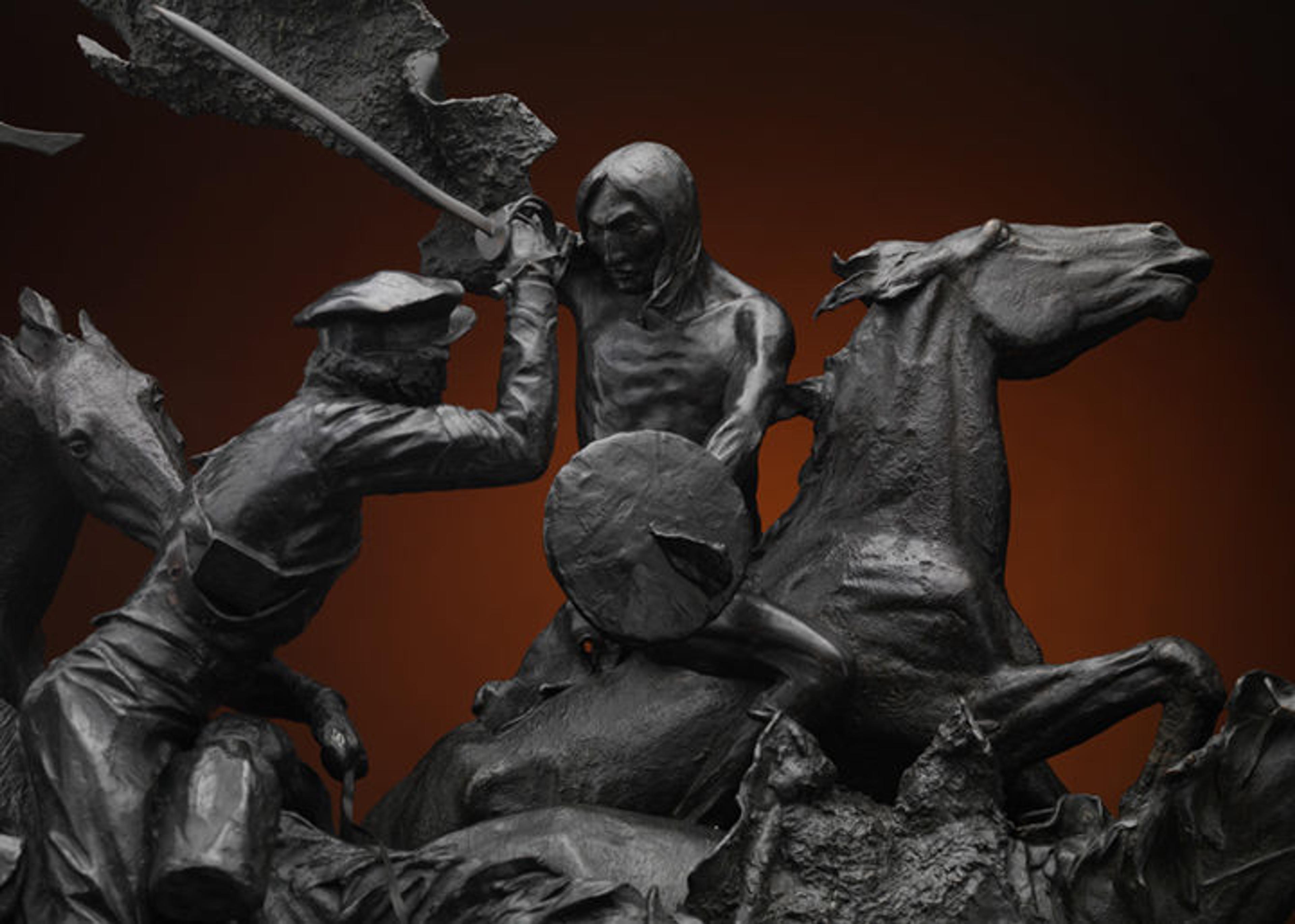
Detail of Remington's Old Dragoons of 1850

Detail of Remington's Old Dragoons of 1850
Around 1900, Remington began working exclusively with Roman Bronze Works foundry in New York, which cast sculptures through a process called lost-wax, rather than by sand casting. Lost-wax technology, although thousands of years old, was new to the United States, and Remington was one of the first US-based artists to exploit its possibilities—all the more impressive since he was self-trained as a sculptor.
The fact that The Met's Old Dragoons, purchased directly from the artist in 1907, is one of only three casts of this statuette produced during his lifetime is testament to the time-consuming and laborious production process. Remington remained closely involved with the casting, collaborating with foundry workers throughout the various steps of the process. He delighted in being able to make changes in the wax models, from cast to cast, to modify compositional and surface details. Indeed, close visual comparison between The Met's bronze and two other casts made during the artist's lifetime—at the Amon Carter Museum of American Art and the Art Institute of Chicago—reveals dozens of variations among the fine details of the work.
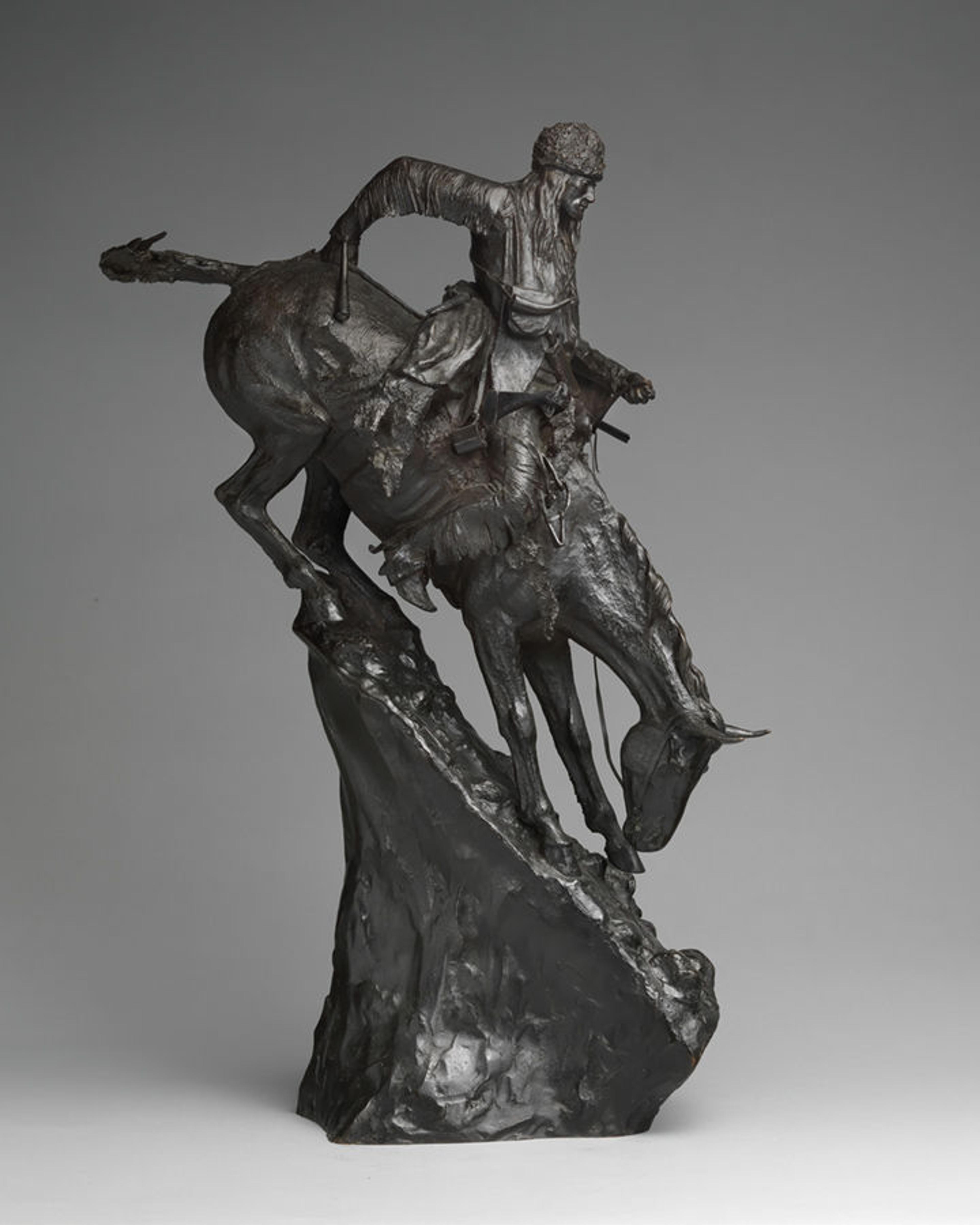
Frederic Remington (American, 1861–1909). The Mountain Man, 1903, cast by March 1907. Bronze, 27 3/4 x 12 x 10 in. (70.5 x 30.5 x 25.4 cm). The Metropolitan Museum of Art, New York, Purchase, Rogers Fund, 1907 (07.79)
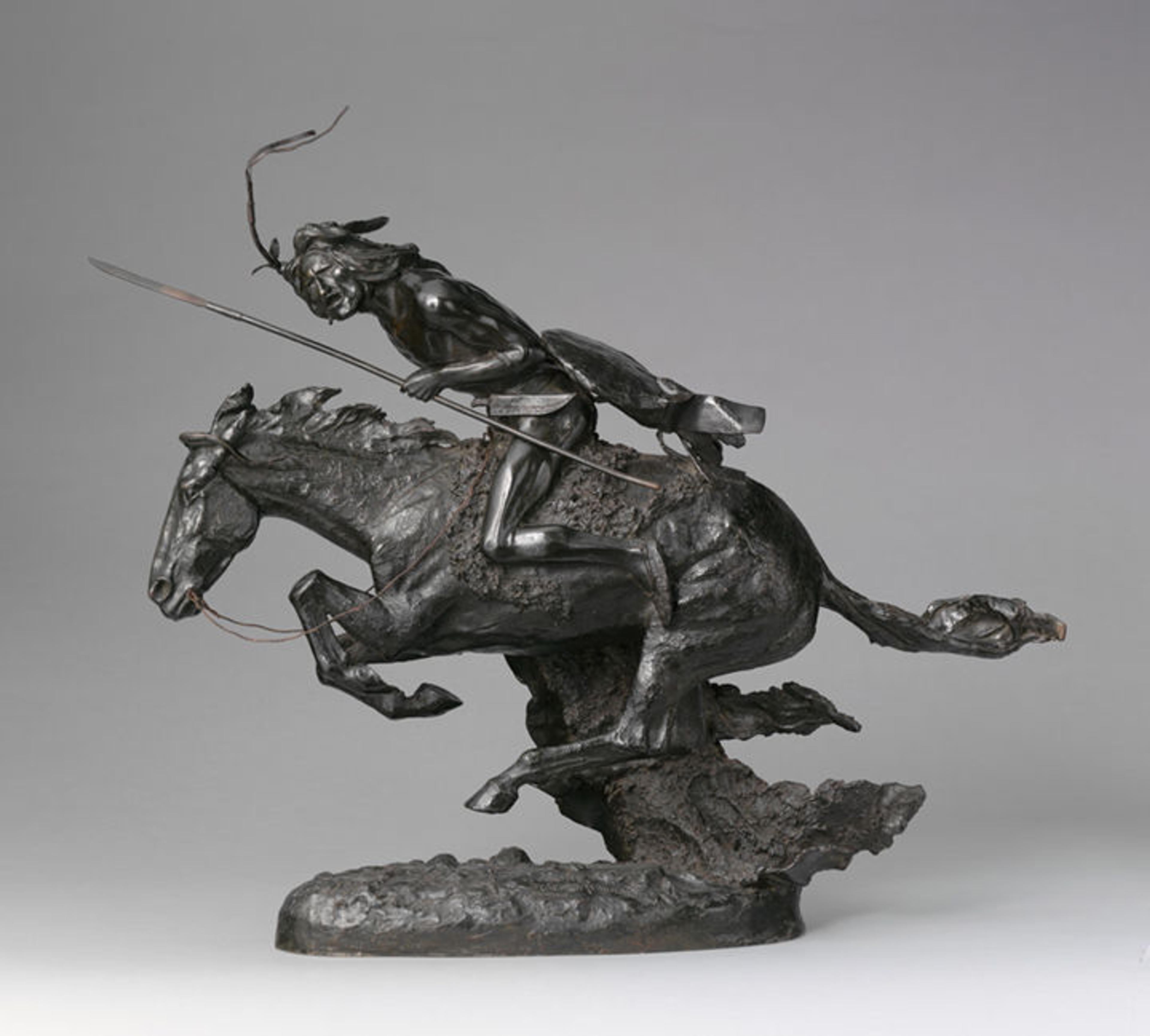
Frederic Remington (American, 1861–1909). The Cheyenne, 1901, cast by March 1907. Bronze, 20 1/4 x 25 x 8 in. (51.4 x 63.5 x 20.3 cm). The Metropolitan Museum of Art, New York, Purchase, Rogers Fund, 1907 (07.80)
Remington was constantly pushing the limits of bronze casting—his Cheyenne and Mountain Man were lost-wax cast in one and two pieces, respectively. (Ancillary elements such as bridles, reins, and weapons were produced and attached separately.) The facture of these bronzes marked an astounding departure from sand casting, a process that required sculptures to be cast in multiple pieces and then mechanically assembled.
Old Dragoons was made as an indirect lost-wax cast, meaning Remington did not model the sculpture directly in wax (as is the case for direct lost-wax casts), but rather the bronze was cast from a wax inter-model produced at the foundry. Wax inter-models (which Remington was able to modify) would have been produced from molds taken from the artist's original clay model. Because of its multi-figure composition, Remington, out of necessity, approached Old Dragoons differently than he would a typical wax cast, and assembled it from multiple separately cast parts.

Radiograph of lead horse and front soldier with wax-to-wax joins and core pins visible.
The technical study of Old Dragoons undertaken by The Met's Departments of Objects Conservation and Scientific Research included visual examination, computed radiography (CR), and materials analysis. Although the overlapping forms made it difficult to image individual areas, radiography confirmed that horse and rider forms are hollow, with the riders' legs open to the interior of the horses' bodies. Although some of the iron core pins used in the casting process remain in the interior, the plaster cores were removed before assembling the sculpture to reduce the weight carried by the slender legs of the horses (even so, the sculpture still weighs more than two hundred pounds).
Radiography revealed that the wax inter-models were built up in sections, with wax-to-wax joins in areas, such as limbs and the horses' necks. Visual evidence indicates that some of the raised or deeply undercut surface details, such as the loincloths, the horses' manes and ears, and the bison hide on the riderless horse, were modeled in wax separately and applied to the inter-models before casting, which accounts for numerous differences in the three lifetime casts.

Detail of Remington's Old Dragoons of 1850
We were able to distinguish at least twenty individually cast elements within The Met's Old Dragoons, including the lone lead horse; the four horses and riders; the Native Americans' raised right arms; the left arm of the second soldier; the bison hide brandished by the lead Native American; the hide that dangles from the horse at rear left; the tails on the soldiers' horses; the soldiers' sabers, scabbards, and rifles; and the tassels soldered to the soldiers' wrist lanyards. The main forms of the sculpture were assembled with threaded rods and pins. Joins were disguised by smoothing the seams with steel tools and further concealed with the application of the dark-brown patina. The soldiers' weapons were attached with hooks, links, and flexible metal strapping similar to that used for the reins.
The base was thickly cast (one quarter to three-eighths of an inch in thickness) and is hollow on the underside, with seven small, cupped depressions cast in the upper surface so that short tangs—or projections—cast under the seven hooves that contact the ground could be inserted. The Native Americans' horses are joined at their rear hooves, and the soldiers' horses and the lone lead horse are each joined at a single hoof. The lead horse's front left hoof is attached with a large tapered pin, which was inserted horizontally through a hole drilled in the front edge of the base, across the cup and the tang under the horse's hoof. The four horses and riders are connected with short rods that were threaded into the tangs, inserted through holes in the cups on the base, and secured with nuts on the underside.
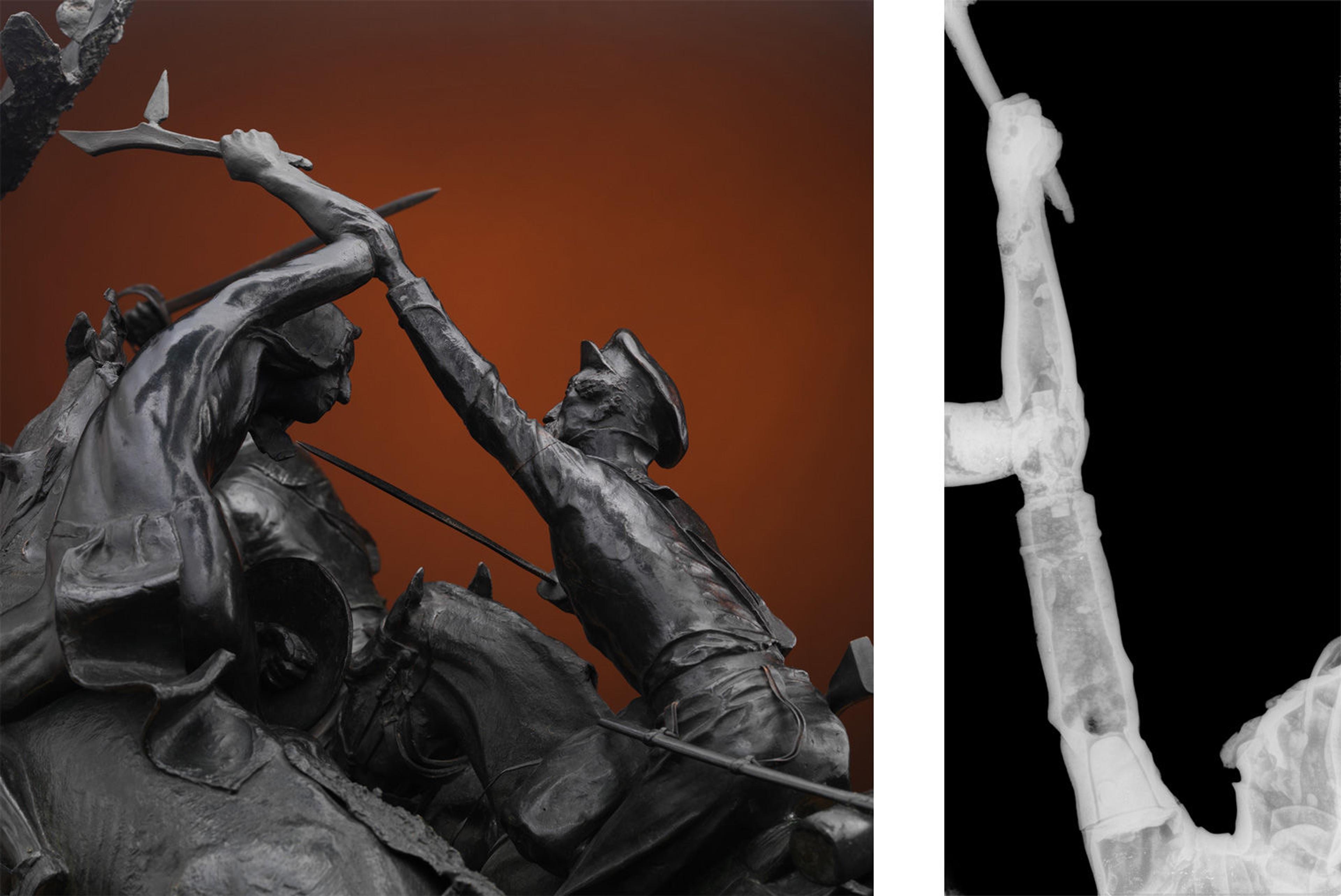
Detail of Remington's Old Dragoons of 1850. At right is a detail of a radiograph showing internal joins at the Dragoon's shoulder and grasping hand.
A number of separately cast elements were used as bridging elements that function as struts to connect the figures and provide structural stability to the largely airborne horses and riders. The two leading horses are joined directly by a pin that connects the front right hoof of the Native American's horse to a flying edge of the bison hide on the lone horse's saddle. The tail of the front soldier's horse is pinned to the trailing horse at the base of its tail and the right calf of the trailing Dragoon. The second soldier and Native American are connected with a bridge formed by their arms, which are joined with an internal pin at the grasping hand, and with sleeve joins at their upper arms. The bison hide that dangles from the horse at rear left was attached, by pinning, at the horse's right hip and to the foreground in front of the second soldier, acting as a buttress for the rearing horse.
These visual observations were complemented by identifying the typology of metal used to cast the different elements of the sculpture. To do so, we turned to x-ray fluorescence spectroscopy (XRF), a technique that takes advantage of the complex interactions between a beam of x-rays of known energy and the surface of the metal in order to identify the chemical elements present in the metal itself. Because this analysis is entirely noninvasive, XRF allows specialists to characterize and compare the alloy of a large number of the bronze's parts without the need to collect metal samples from the sculpture.
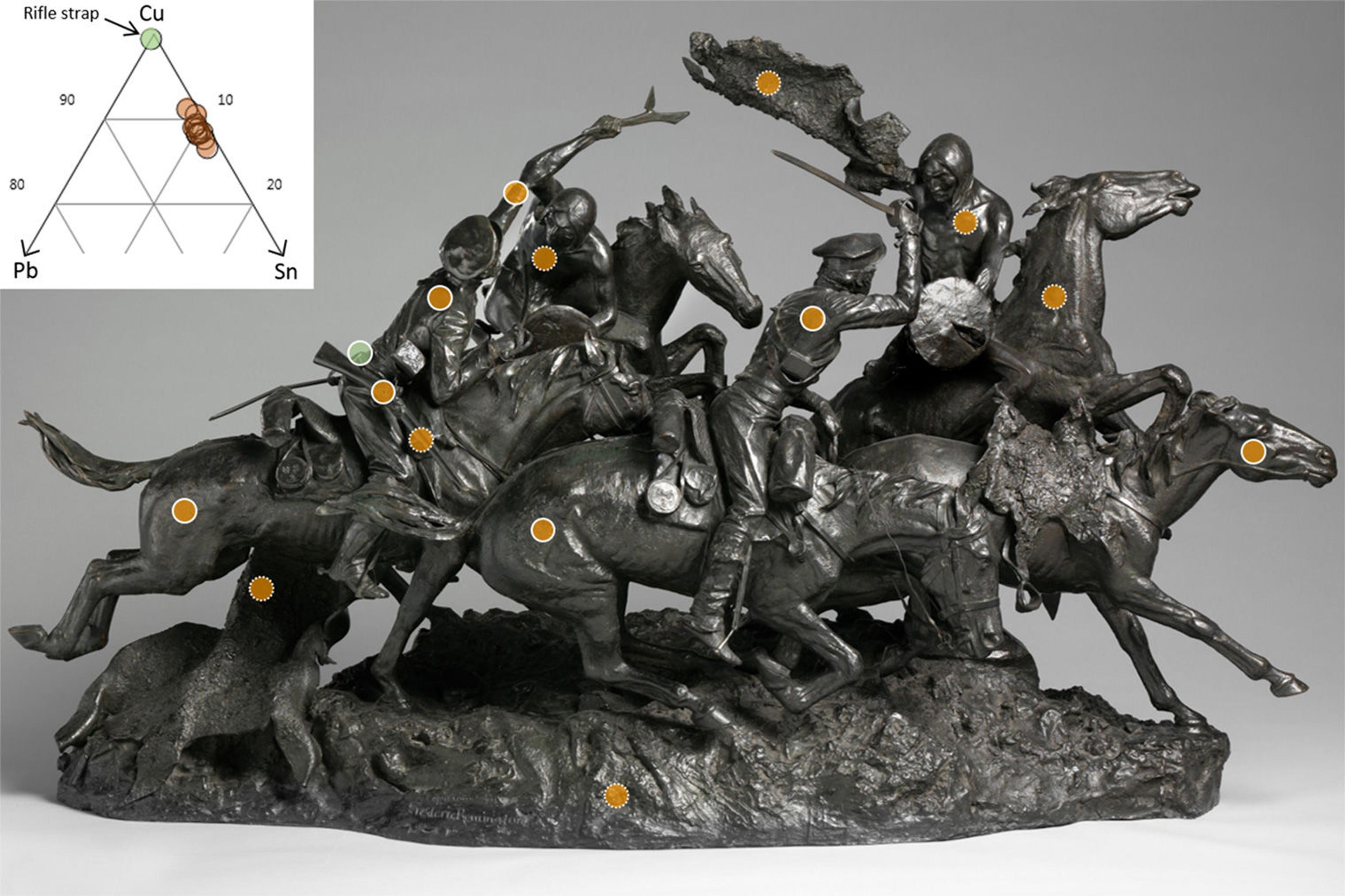
Location of the XRF analysis on the Remington's Old Dragoons of 1850. The alloy compositions are plotted on a ternary diagram according to the relative amounts of copper (Cu), tin (Sn), and lead (Pb). All the analyzed parts share a similar alloy composition (in orange), with the exception of the rifle strap (in green). Dashed points indicate that the analysis was taken on the opposite side of the sculpture.
By means of XRF, we identified the main metal of the sculpture as bronze—a binary alloy of copper and tin—with trace amounts of lead and zinc, as well as minor quantities of arsenic and nickel. The sculpture's average alloy, expressed in weight percentage, consists of 87.3 ± 1 percent copper, 9.9 ± 1 percent tin, 1.1 ± 0.3 percent lead, and 0.7 ± 0.1 percent zinc; other elements, such as arsenic and nickel are present below 0.2 percent. Variable amounts of iron were also recorded, most likely due to an uneven patina at the sculpture's surface.
Despite a slight variation in the contents of lead and zinc, most of the parts we analyzed (that is, the sculpture's base, horses, riders, and rifle) share a very similar chemical composition. This suggests that the main pieces of the sculpture all made use of the same bronze alloy, whose calculated composition is consistent with the relatively low-zinc and low-lead alloys used by Roman Bronze Works in casting Remington's bronzes during the artist's lifetime. Only the small, flat attached elements, such as belts and bridles, are composed of a different alloy: one of almost pure copper (97.4 percent copper) containing traces of zinc and lead.
During the course of this study, we took the opportunity to address a long-lost detail: many years ago, one of the soldiers' .52-caliber carbine had detached from the sculpture, and was missing. We took an impression of the existing rifle using a quick-setting silicone dental casting putty. We then used this mold to create a wax, which will be cast in brass, patinated to resemble the original, and applied to the sculpture using a similar hook.
This extensive collaborative study gave us the answers we sought, some open-ended and some conclusive. Knowing that Old Dragoons was cast in some twenty pieces yields fresh insights into both Remington's creative process and the intriguing steps of bronze casting. As we continue to discover more about the construction of historic American bronzes in The Met collection, we can apply lessons learned from this inquiry to the study of other works by Remington and his contemporaries.
Related Content
Frederic Remington's The Old Dragoons of 1850 is currently on view in gallery 765 of the American Wing.
Barrymore Laurence Scherer, "Frederic Remington at the Met Review: A Varied, Brilliant Career Cut Short," Wall Street Journal (August 22, 2017). Readership subscription required.
Heilbrunn Timeline of Art History: "Frederic Remington (1861–1909)" and "American Bronze Casting."
Michael D. Greenbaum, Icons of the West: Frederic Remington's Sculpture (Ogdensburg, NY: Frederic Remington Art Museum, 1996).
Read a blog series published in conjunction with the exhibition The American West in Bronze, 1850–1925, which was on view at The Met Fifth Avenue from December 18, 2013, through April 13, 2014.
Linda Borsch
Linda Borsch is a conservator in the Department of Objects Conservation.
Federico Carò
Federico Carò is a research scientist in the Department of Scientific Research. He was formerly the Andrew W. Mellon Fellow in the Museum's Department of Scientific Research.
Thayer Tolles
Thayer Tolles is Marica F. Vilcek Curator of American Painting and Sculpture in The American Wing.